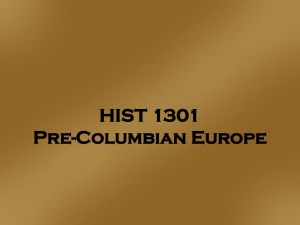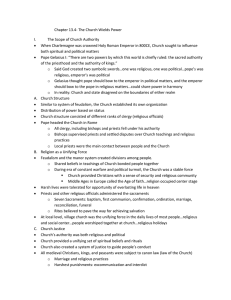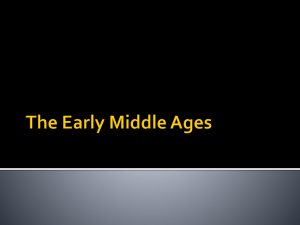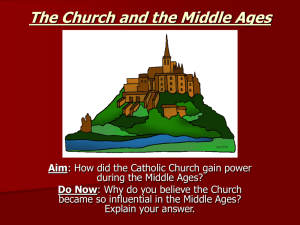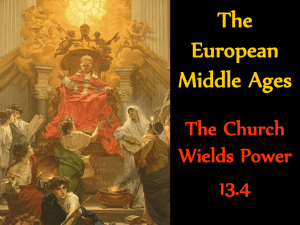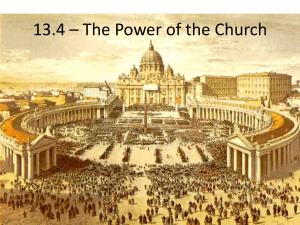Power of the Church: Medieval History Textbook Excerpt
advertisement
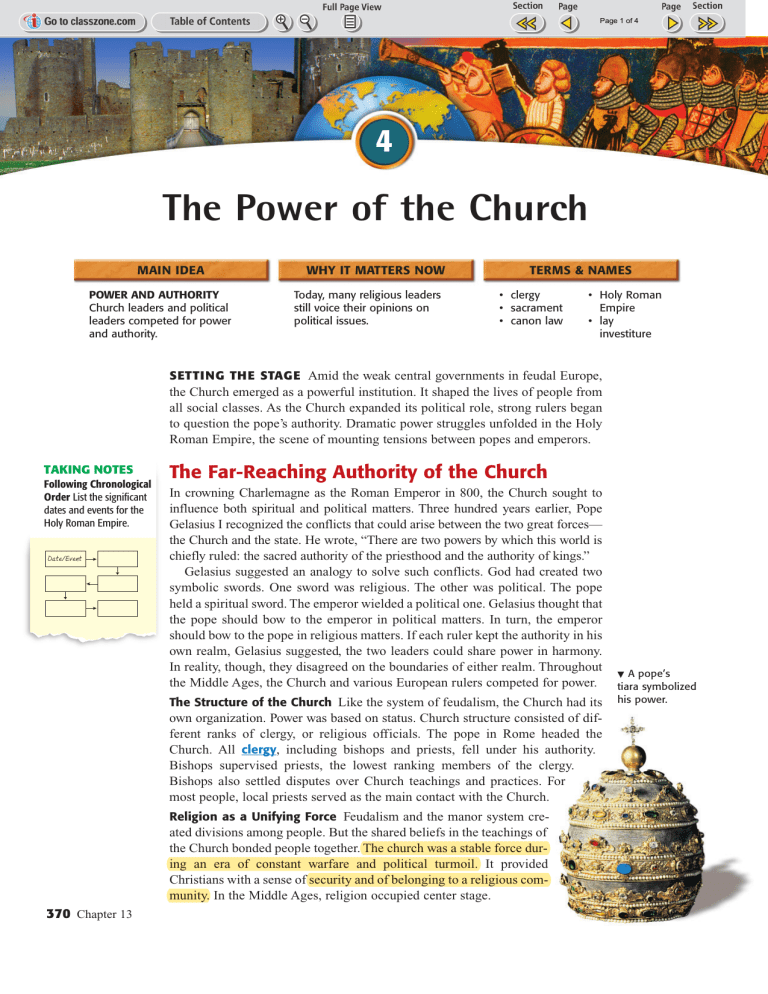
Page 1 of 4 4 The Power of the Church MAIN IDEA POWER AND AUTHORITY Church leaders and political leaders competed for power and authority. WHY IT MATTERS NOW Today, many religious leaders still voice their opinions on political issues. TERMS & NAMES • clergy • sacrament • canon law • Holy Roman Empire • lay investiture SETTING THE STAGE Amid the weak central governments in feudal Europe, the Church emerged as a powerful institution. It shaped the lives of people from all social classes. As the Church expanded its political role, strong rulers began to question the pope’s authority. Dramatic power struggles unfolded in the Holy Roman Empire, the scene of mounting tensions between popes and emperors. TAKING NOTES Following Chronological Order List the significant dates and events for the Holy Roman Empire. Date/Event The Far-Reaching Authority of the Church In crowning Charlemagne as the Roman Emperor in 800, the Church sought to influence both spiritual and political matters. Three hundred years earlier, Pope Gelasius I recognized the conflicts that could arise between the two great forces— the Church and the state. He wrote, “There are two powers by which this world is chiefly ruled: the sacred authority of the priesthood and the authority of kings.” Gelasius suggested an analogy to solve such conflicts. God had created two symbolic swords. One sword was religious. The other was political. The pope held a spiritual sword. The emperor wielded a political one. Gelasius thought that the pope should bow to the emperor in political matters. In turn, the emperor should bow to the pope in religious matters. If each ruler kept the authority in his own realm, Gelasius suggested, the two leaders could share power in harmony. In reality, though, they disagreed on the boundaries of either realm. Throughout the Middle Ages, the Church and various European rulers competed for power. The Structure of the Church Like the system of feudalism, the Church had its own organization. Power was based on status. Church structure consisted of different ranks of clergy, or religious officials. The pope in Rome headed the Church. All clergy, including bishops and priests, fell under his authority. Bishops supervised priests, the lowest ranking members of the clergy. Bishops also settled disputes over Church teachings and practices. For most people, local priests served as the main contact with the Church. Religion as a Unifying Force Feudalism and the manor system cre- ated divisions among people. But the shared beliefs in the teachings of the Church bonded people together. The church was a stable force during an era of constant warfare and political turmoil. It provided Christians with a sense of security and of belonging to a religious community. In the Middle Ages, religion occupied center stage. 370 Chapter 13 A pope’s tiara symbolized his power. ▼ Page 2 of 4 Analyzing Motives Why did medieval peasants support the Church? Medieval Christians’ everyday lives were harsh. Still, they could all follow the same path to salvation—everlasting life in heaven. Priests and other clergy administered the sacraments, or important religious ceremonies. These rites paved the way for achieving salvation. For example, through the sacrament of baptism, people became part of the Christian community. At the local level, the village church was a unifying force in the lives of most people. It served as a religious and social center. People worshiped together at the church. They also met with other villagers. Religious holidays, especially Christmas and Easter, were occasions for festive celebrations. The Law of the Church The Church’s authority was both religious and political. It provided a unifying set of spiritual beliefs and rituals. The Church also created a system of justice to guide people’s conduct. All medieval Christians, kings and peasants alike, were subject to canon law, or Church law, in matters such as marriage and religious practices. The Church also established courts to try people accused of violating canon law. Two of the harshest punishments that offenders faced were excommunication and interdict. Popes used the threat of excommunication, or banishment from the Church, to wield power over political rulers. For example, a disobedient king’s quarrel with a pope might result in excommunication. This meant the king would be denied salvation. Excommunication also freed all the king’s vassals from their duties to him. If an excommunicated king continued to disobey the pope, the pope, in turn, could use an even more frightening weapon, the interdict. Under an interdict, many sacraments and religious services could not be performed in the king’s lands. As Christians, the king’s subjects believed that without such sacraments they might be doomed to hell. In the 11th century, excommunication and the possible threat of an interdict would force a German emperor to submit to the pope’s commands. An Age of Superstition Lacking knowledge of the laws of nature, many people during the Middle Ages were led to irrational beliefs. They expected the dead to reappear as ghosts. A friendly goblin might do a person a good deed, but an evil witch might cause great harm. Medieval people thought an evil witch had the power to exchange a healthy child for a sickly one. The medieval Church frowned upon superstitions such as these: • preparing a table with three knives to please good fairies • making a vow by a tree, a pond, or any place but a church • believing that a person could change into the shape of a wolf • believing that the croak of a raven or meeting a priest would bring a person good or bad luck The Church and the Holy Roman Empire When Pope Leo III crowned Charlemagne emperor in 800, he unknowingly set the stage for future conflicts between popes and emperors. These clashes would go on for centuries. Otto I Allies with the Church The most effective ruler of medieval Germany was Otto I, known as Otto the Great. Otto, crowned king in 936, followed the policies of his hero, Charlemagne. Otto formed a close alliance with the Church. To limit the nobles’ strength, he sought help from the clergy. He built up his power base by gaining the support of the bishops and abbots, the heads of monasteries. He dominated the Church in Germany. He also used his power to defeat German princes. Following in Charlemagne’s footsteps, Otto also invaded Italy on the pope’s behalf. In 962, the pope rewarded Otto by crowning him emperor. Signs of Future Conflicts The German-Italian empire Otto created was first called the Roman Empire of the German Nation. It later became the Holy Roman Empire. It remained the strongest state in Europe until about 1100. However, European Middle Ages 371 Page 3 of 4 Otto’s attempt to revive Charlemagne’s empire caused trouble for future German leaders. Popes and Italian nobles, too, resented German power over Italy. The Emperor Clashes with the Pope The Church was not happy that kings, such as Otto, had control over clergy and their offices. It especially resented the practice of lay investiture, a ceremony in which kings and nobles appointed church officials. Whoever controlled lay investiture held the real power in naming bishops, who were very influential clergy that kings sought to control. Church reformers felt that kings should not have that power. In 1075, Pope Gregory VII banned lay investiture. The furious young German emperor, Henry IV, immediately called a meeting of the German bishops he had appointed. With their approval, the emperor ordered Gregory to step down from the papacy. Gregory then excommunicated Henry. Afterward, German bishops and princes sided with the pope. To save his throne, Henry tried to win the pope’s forgiveness. Showdown at Canossa In January 1077, Henry crossed the snowy Alps to the Italian town of Canossa (kuh•NAHS•uh). He approached the castle where Gregory was a guest. Gregory later described the scene: PRIMARY SOURCE There, having laid aside all the belongings of royalty, wretchedly, with bare feet and clad in wool, he [Henry IV] continued for three days to stand before the gate of the castle. Nor did he desist from imploring with many tears the aid and consolation of the apostolic mercy until he had moved all of those who were present there. POPE GREGORY, in Basic Documents in Medieval History The Holy Roman Empire, 1100 16°E 8°E 0° 24°E 0 Friesland . Franconia Worms FRANCE 400 Kilometers POLAND eR Lorraine 0 Saxony E lb ne R. Rhi Aachen 50°N 200 Miles Swabia KINGDOM OF HUNGARY Bavaria Rhône R. Burgundy Carinthia Lombardy Po R. Tuscany Spoleto c ti Rome ria Mediterranean Sea The Holy Roman Empire Papal States Ad Papal States 42°N Concordat of Worms The succes- Bohemia Danube R . Se a GEOGRAPHY SKILLBUILDER: Interpreting Maps 1. Region How many states made up the Holy Roman Empire? What does this suggest about ruling it as an empire? 2. Location How did the location of the Papal States make them an easy target for frequent invasions by Germanic rulers? 372 The Pope was obligated to forgive any sinner who begged so humbly. Still, Gregory kept Henry waiting in the snow for three days before ending his excommunication. Their meeting actually solved nothing. The pope had humiliated Henry, the proudest ruler in Europe. Yet, Henry felt triumphant and rushed home to punish rebellious nobles. sors of Gregory and Henry continued to fight over lay investiture until 1122. That year, representatives of the Church and the emperor met in the German city of Worms (wurms). They reached a compromise known as the Concordat of Worms. By its terms, the Church alone could appoint a bishop, but the emperor could veto the appointment. During Henry’s struggle, German princes regained power lost under Otto. But a later king, Frederick I, would resume the battle to build royal authority. Making Inferences Why was Henry’s journey to Canossa a political act? Page 4 of 4 Disorder in the Empire By 1152, the seven princes who elected the German king realized that Germany needed a strong ruler to keep the peace. They chose Frederick I, nicknamed “Barbarossa” for his red beard. Vocabulary Barbarossa means “red beard” in Italian. The Reign of Frederick I Frederick I was the first ruler to call his lands the Holy Roman Empire. However, this region was actually a patchwork of feudal territories. His forceful personality and military skills enabled him to dominate the German princes. Yet, whenever he left the country, disorder returned. Following Otto’s example, Frederick repeatedly invaded the rich cities of Italy. His brutal tactics spurred Italian merchants to unite against him. He also angered the pope, who joined the merchants in an alliance called the Lombard League. In 1176, the foot soldiers of the Lombard League faced Frederick’s army of mounted knights at the Battle of Legnano (lay•NYAHN•oh). In an astonishing victory, the Italian foot soldiers used crossbows to defeat feudal knights for the first time in history. In 1177, Frederick made peace with the pope and returned to Germany. His defeat, though, had undermined his authority with the German princes. After he drowned in 1190, his empire fell to pieces. German States Remain Separate German kings after Frederick, including his grandson Frederick II, continued their attempts to revive Charlemagne’s empire and his alliance with the Church. This policy led to wars with Italian cities and to further clashes with the pope. These conflicts were one reason why the feudal states of Germany did not unify during the Middle Ages. Another reason was that the system of German princes electing the king weakened royal authority. German rulers controlled fewer royal lands to use as a base of power than French and English kings of the same period, who, as you will learn in Chapter 14, were establishing strong central authority. Analyzing Causes What political trend kept German states separate during the Middle Ages? SECTION 4 This manuscript shows Frederick I at the height of his imperial power. ▲ ASSESSMENT TERMS & NAMES 1. For each term or name, write a sentence explaining its significance. • clergy • sacrament • canon law • Holy Roman Empire • lay investiture USING YOUR NOTES MAIN IDEAS CRITICAL THINKING & WRITING 2. Which of the events were 3. What were some of the matters 6. COMPARING How was the structure of the Church like power struggles between the Church and rulers? Explain. Date/Event covered by canon law? 4. How did Otto the Great make the crown stronger than the German nobles? 5. Why did lay investiture cause a struggle between kings and popes? that of the feudal system? 7. EVALUATING DECISIONS Was the Concordat of Worms a fair compromise for both the emperor and the Church? Why or why not? 8. DRAWING CONCLUSIONS Why did German kings fail to unite their lands? 9. WRITING ACTIVITY POWER AND AUTHORITY Why did Henry IV go to Canossa to confront Pope Gregory VII? Write a brief dialogue that might have taken place between them at their first meeting. CONNECT TO TODAY CREATING A CHART Research the ruling structure of the modern Roman Catholic Church and then create a chart showing the structure, or hierarchy. European Middle Ages 373
